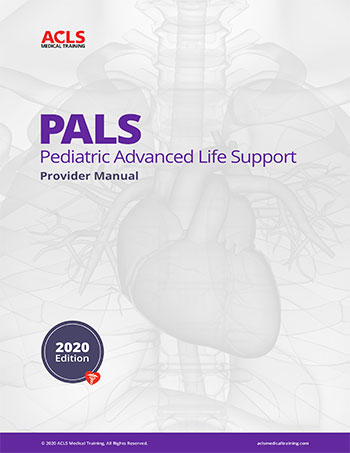At ACLS Medical Training, we strive to have the highest quality PALS certification curriculum.
How to Use Our PALS Study Materials
The Experienced Provider
If you are already a PALS provider and are confident in your knowledge and skills, familiarize yourself with the topics and content in the PALS provider manual, most notably the updated guidelines.
The First Time Student
If this is your first time seeking a PALS certification, we recommend going through the PALS provider manual very carefully. The topics and content may be new for you. Since any part of it could be on the exam, you will need to be prepared. You should be very comfortable with the PALS algorithms before you attempt the certification exam. The PALS practice test is a good way to check your knowledge level before you take the PALS certification examination.
A Provider with a Lapsed Certification
If it has been more than two years since you had PALS certification, you will want to determine which areas you may have forgotten since your last certification. For most people, this will be the medication doses or the algorithms. We have that content in our Education Center and in the PALS provider manual. Once you have refreshed your memory, you may be ready to take the PALS recertification examination.
The PALS Study Guide Table of Contents
- General Concepts
- PALS Preparation
- Organization of the PALS Course
- PALS Guideline Changes
- Changes to Pediatric BLS
- Pediatric Chain of Survival
- Pediatric Evaluation
- Evaluate-Identify-Intervene
- Evaluate the Child
- Identify
- Intervene
- Evaluate-Identify-Intervene
- The Team in PALS
- Recognition of Respiratory Distress/Failure
- Hypoxemia
- Hypercarbia
- Signs of Respiratory Problems
- Management of Pediatric Respiratory Distress or Failure
- Upper Airway Obstruction Management
- Lower Airway Obstruction Management
- Lung Tissue Disease Management
- Disordered Control of Breathing Management
- Equipment for Respiratory Management
- Pediatric Length Based Resuscitation Tape
- Recognition of Pediatric Shock
- Pathophysiology in Shock
- Compensatory Mechanisms in Shock
- Signs of Shock by Type
- Management of Pediatric Shock
- Initial Management
- Management of Shock by Type
- Shock: Fluid and Medications
- Intraosseus Access
- Recognition and Management of Pediatric Bradycardia
- Signs and Symptoms of Bradycardia
- Underlying Causes of Bradycardia
- Bradycardia with a Pulse and Poor Perfusion Sequence
- Recognition and Management of Pediatric Tachycardia
- Signs and Symptoms of Tachycardia
- Initial Management of Tachycardia and Emergency Interventions
- Tachycardia with Adequate Perfusion Sequence
- Tachycardia with Poor Perfusion Sequence
- Recognition and Management of Pediatric Cardiac Arrest
- Cardiac Arrest Rhythms
- BLS Components for Management of Cardiac Arrest
- Advanced Life Support (ALS) in Cardiac Arrest
- Pediatric Cardiac Arrest Sequence
- Manual Defibrillation for VF or Pulseless VT
- Special Circumstances
- Pediatric Post-Resuscitation Support
- DOPE
- Maintenance Fluids
- Management of Shock Following Successful Resuscitation
- Patient Transport
- Medications Used in PALS
- Rhythm Recognition
- Sinus Rhythm
- Sinus Bradycardia
- Sinus Tachycardia
- Sinus Rhythm with 1st Degree Heart Block
- 2nd Degree AV Heart Block
- 3rd Degree Heart Block
- Supraventricular Tachycardia (SVT)
- Atrial Fibrillation
- Atrial Flutter
- Ventricular Tachycardia (VT)
- Ventricular Fibrillation (VF)
- Asystole
